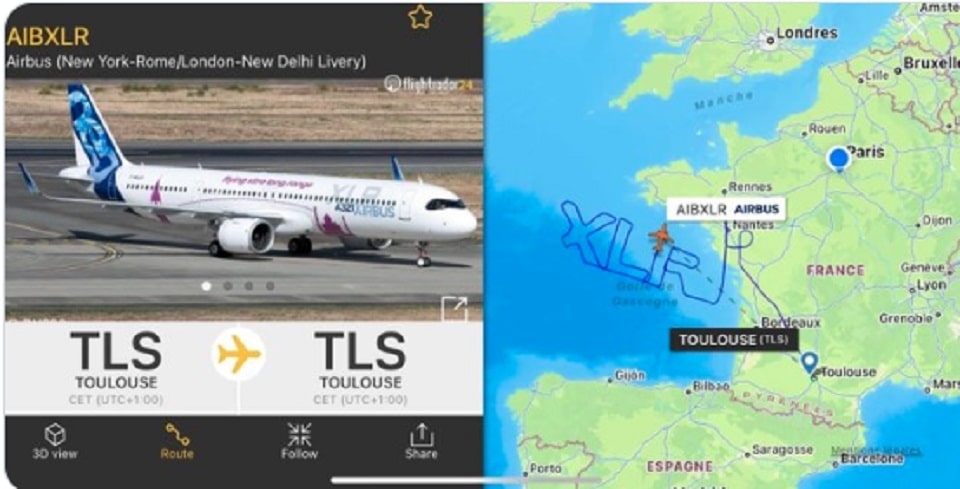Aerospace
The first 13-hour test flight of the A321XLR was successfully accomplished.

The Airbus A321 XLR is the longest-flying narrow-body aircraft, and it recently showed that it is capable of flying above Toulouse. Additionally, it performs a flying display and draws an XLR over the sky, both of which are readily visible from flight radar 24.
[adinserter block="3"]
The flight test that "says" it all!
Check out the cool flight path of the #A321XLR’s 13-hr and 15-min flight test earlier today! pic.twitter.com/5w2DSaJy1s— Airbus (@Airbus) December 13, 2022
The engine and aerodynamic upgrades made to the A321neo are where the A321XLR gets its Xtra Long Range capability. The A321XLR has the unusual potential to fly up to 4,700nm thanks to a larger Maximum Take-Off Weight (MTOW) and increased fuel capacity.
[adinserter block="1"]
American airlines Insight view of A321XLR(Opens in a new browser tab)
The A321XLR offers airlines significant financial benefits. The A321XLR consumes up to 30% less fuel per seat than older models of aircraft.
China’s top 3 airlines will purchase nearly 300 Airbus A320neo aircraft.(Opens in a new browser tab)
All clear for take off!?
Follow the #A321XLR if you have more than a few hours to spare?…
Watch this space!https://t.co/IEJQgH4GRk pic.twitter.com/PmKRt9poWm— Airbus (@Airbus) December 13, 2022
This is a significant accomplishment for Airbus and the global A320 Family of clients. Airlines will be able to provide long-haul comfort on a single aisle with the introduction of the A321XLR thanks to its distinctive Airspace cabin.
[adinserter block="3"]
Top 5 selling Narrow Body aircraft(Opens in a new browser tab)
The A321XLR is the next development in the single-aisle A320neo family, answering market demands for expanded range and cargo while adding more value for airlines by making it possible to offer commercially viable services on longer routes than any other aircraft model.
Un vol de plus de 13 heures pour l’Airbus A321XLR https://t.co/8KXXxzXfvM pic.twitter.com/Uh77Qtwws8
— Air Journal (@airjournal) December 14, 2022
The A321XLR will have a single-aisle aircraft range of up to 4,700nm (8700 km), which is unprecedented. It will also use 30% less fuel per seat than previous-generation aircraft and produce less noise and NOx emissions.
The A320neo Family has received more than 8,000 orders from more than 130 customers by the end of June 2022. More than 20 customers had placed more than 500 A321XLR orders.

Aerospace
Boeing Transfers Rocket Stage to NASA, Paving Way for Human Moon Mission

Boeing has achieved a significant milestone by providing NASA with the second core stage of the Space Launch System (SLS) rocket.
This crucial component, crafted at NASA’s Michoud Assembly Facility (MAF), is set to propel the Artemis II crew into lunar orbit, marking humanity’s return to deep space after a 50-year hiatus.
The monumental Boeing-built rocket stage, the largest element of the Artemis II mission, will embark on a journey aboard the Pegasus barge, traveling 900 miles to NASA’s Kennedy Space Center.
Comparison of two legendary aircraft B777x vs B747 aircraft:Click here
Upon arrival, it will be meticulously integrated with other essential Artemis II components, including the upper stage, solid rocket boosters, and NASA’s Orion spacecraft within the iconic Vehicle Assembly Building. This intricate integration process is a vital step toward the eagerly anticipated Artemis II launch, slated for 2025.
“Boeing-built products helped land humankind on the moon in 1969, and we’re proud to continue that legacy through the Artemis generation,” remarked Dave Dutcher, vice president and program manager for Boeing’s SLS program. “Together, with NASA and our industry partners and suppliers, we are building the world’s most capable rocket and paving the way to deep space through America’s rocket factory in New Orleans.”
NASA, Lockheed Martin Reveal X-59 Quiet Supersonic Aircraft:Click here
The delivery of Core Stage 2 marks a significant achievement in the evolution of the SLS rocket. Towering over 200 feet and powered by four RS-25 engines, this core stage, coupled with two solid-fueled booster rockets, will generate a staggering 8.8 million pounds of thrust. This immense power is crucial to launching Artemis II and future missions into the vast expanse of space.
The SLS rocket stands unparalleled in its capability to transport both crew and substantial cargo to the moon and beyond in a single launch. Its extraordinary capacity will facilitate the delivery of human-rated spacecraft, habitats, and scientific missions to destinations including the moon and Mars, ushering in a new era of space exploration.
-

 Travel1 week ago
Travel1 week agoAir India to Expand US Operations with Three New Routes After a Decade
-

 Travel2 weeks ago
Travel2 weeks agoWhy We Should Avoid These Stamps in a Passport
-

 Airlines1 month ago
Airlines1 month agoInvestigations Reveal Fake Chinese Titanium in Boeing and Airbus Jets
-

 Tech4 weeks ago
Tech4 weeks agoChina’s CATL Plans 1,800-Mile Electric Plane Launch by 2027
-

 Airport3 days ago
Airport3 days agoTop 10 Largest Airports in the World by Size
-

 Aerospace4 weeks ago
Aerospace4 weeks agoChina’s Fighter Jets Turn Wings into Autonomous Drones
-

 Airlines4 days ago
Airlines4 days agoAir India Rolls Out A350s for Delhi-New York JFK and Newark Routes
-

 Defence3 weeks ago
Defence3 weeks agoBoeing Enhances Chinook with New Engines and Block II Upgrades at $96 Million







